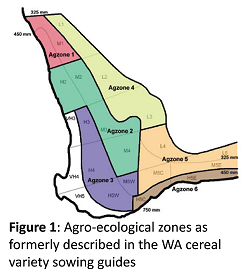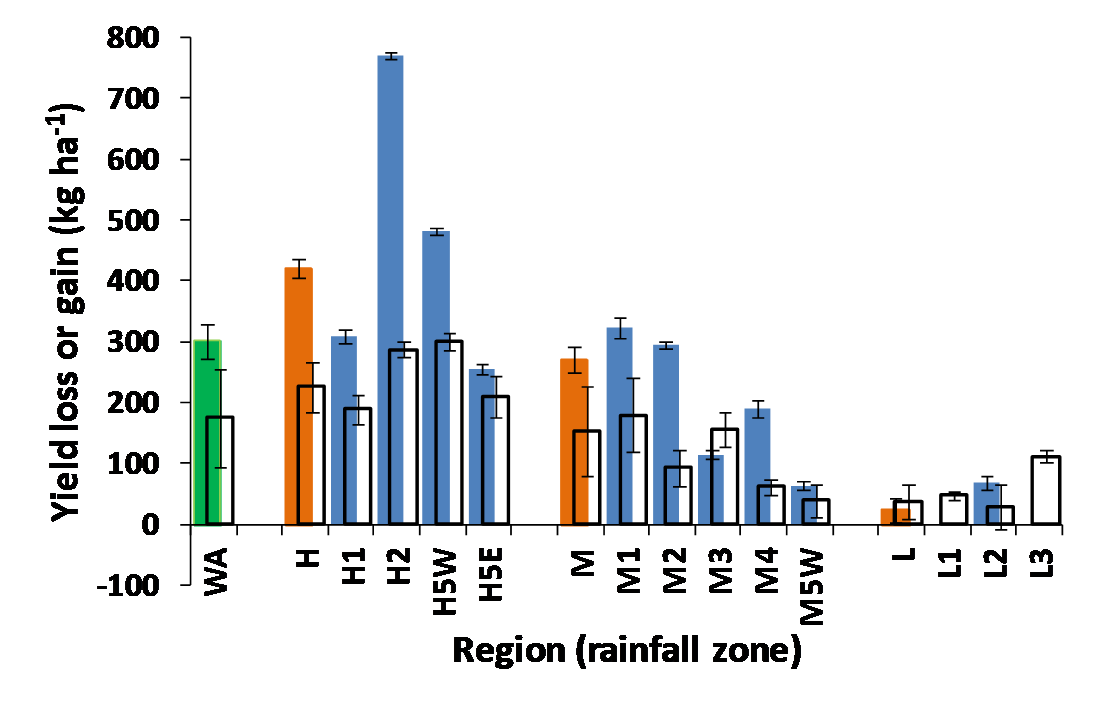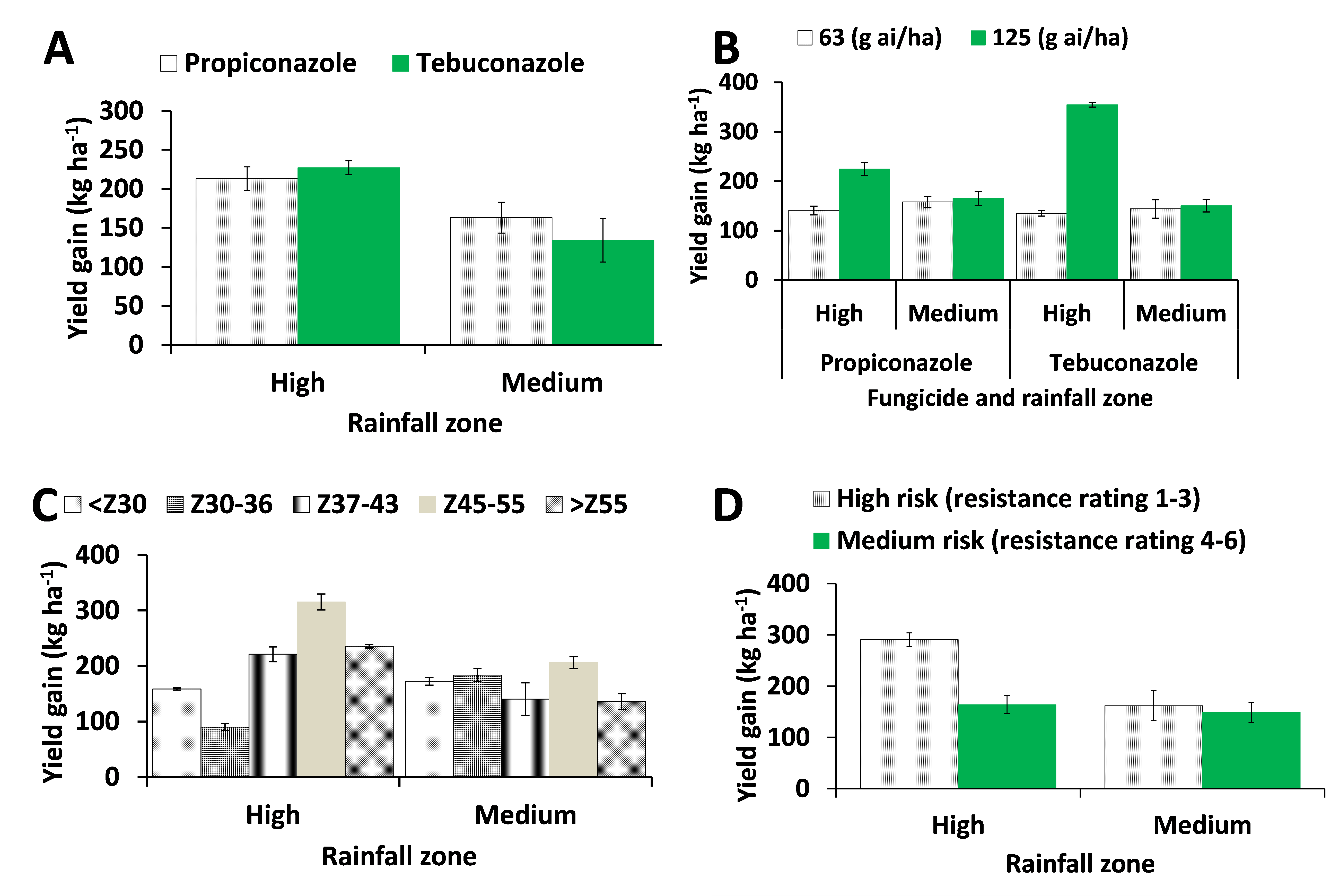A meta-analysis of 30 years of DAFWA's field trials on fungicide management of yellow spot septoria nodorum blotch disease complex of wheat in WA
Author: Kawsar P Salam, Geoff J Thomas, Ciara Beard, Robert Loughman, William J MacLeod and Moin U Salam, DAFWA | Date: 02 Apr 2013
Key Messages
- Average yield loss from YS-SNB disease complex in wheat over thirty years of DAFWA’s field trials in WA was 11.5% equating to 302 kg/ha or $75 /ha. Yield effects in individual experiments ranged from -300 to 1760 kg/ha.
- The higher rainfall zone suffers greater yield losses from YS-SNB disease complex than medium and low rainfall zones.
- Application of one fungicide spray can recover some of this loss to provide economic returns (break even yield ~ 60 kg/ha) in high and medium rainfall zones, but is unlikely to be economic in the low rainfall zone.
- Differences in response to fungicide product (tebuconazole, propiconazole or newer products) were not clearly evident in yield response, whereas higher rates, regardless of fungicide, significantly increased yield response in the high rainfall zone.
- A significant yield response was evident when disease level was at least 10% leaf area affected on the second top leaf at the time of spray.
- The more rain-days (having at least 2 mm per day) the crop received in the 10-day period after spraying, the greater the yield response.
Abbreviations
CI: 95% confidence interval; DAFWA: Department of Agriculture and Food Western Australia; HRZ: high rainfall zones; H1 (H2, H5E, H5W, MRZ, M1, M2, M3, M4, M5W, L1, L2, L3): Agro-ecological zones as formerly described in the WA cereal variety sowing guides (Figure 1). N: number of data-points; ns: not statistically significant; LRZ: low rainfall zones; p: probability level of statistical significance; R2: coefficient of determination of regression equation; RQMS: DAFWA’s Research Quality Management Systems; RIS: DAFWA’s Research Information System; SNB: septoria nodorum blotch; WA: Western Australia; YS: yellow spot

Aims
Using a meta-analysis technique, analyse a large data-set from 30 years of trials conducted by DAFWA on yield response to fungicide control of the YS-SNB disease complex on wheat in WA to quantify (i) yield loss from these diseases in WA and its rainfall zones, (ii) yield response to individual variables and (iii) combined and individual contribution of these variables to the yield response to one application of fungicide.
Methods
The RIS and RQMS databases of DAFWA were used for sourcing data, which comprised experimental results on fungicide response to YS-SNB disease complex on wheat between 1982 and 2011 in the northern, southern and central agricultural regions of WA. Detailed methodology of the analysis is shown elsewhere (Salam et al 2013). Estimates of potential yield loss were made in trials which included full disease control treatments (3 or more fungicide applications). All yield loss estimates were made by comparing treatment yields to untreated control yield in individual experiments.
Trials across the period of analysis contained a wide range of fungicide treatment combinations and observations, consequently numbers of trials used to assess each variable were different depending on how many trials contained relevant data. Where three or less observations were available, this variable was not included in individual assessments. For the purpose of this report, yield response to single fungicide applications includes data for applications of any product or rate at any growth stage unless otherwise stated. Assessment of economic impact used a wheat price of $250/t and fungicide product and applications costs of $15/ha.
Results
Yield loss from YS-SNB disease complex
Average yield loss from YS-SNB disease complex on wheat in Western Australia was calculated as 302 kg/ha (CI = ±28 kg/ha), or about 11.5% (CI = ±1.1) (Figure 2). This loss equates to about $75/ha. Across individual experiments, yield loss (raw or unstandardised data) varied from -300 to 1760 kg/ha.

Figure 2. Yield loss or gain from YS-SNB disease complex on wheat in WA and its agro-ecological zones based on meta-analysis of experiments conducted during 1982 to 2011. See abbreviations section for acronyms. Solid columns indicate yield loss and open columns indicate yield gain from one application of fungicides.
This yield loss (15.1%, 420 kg/ha) was greatest in high rainfall zones. In medium rainfall zones, the yield loss equated to 10.2%, (271 kg/ha). Significant variability was evident within rainfall zones, reflecting the importance of a range of variables on yield loss. Note, in some zones response to a single fungicide was greater than yield loss. This can be interpreted as unavailability of enough trial data to make appropriate comparison.
Across all zones, average yield response to a single fungicide application was 175 kg/ha (6%) and for a double spray the response was 239 kg/ha. Responses to a single fungicide application ranged from -300 to 1885 kg/ha (raw or unstandardised) in individual trials.
Effect of individual-variables on yield response to one application of fungicide on YS-SNB infected wheat
Response to rainfall zones: Average response to a single fungicide application across all zones was 175 kg/ha, although significant difference between rainfall zones was evident. High rainfall zones responded with much higher yield gain from one application of fungicide compared to the medium and low rainfall zones (Figure 2). Average yield gain in high rainfall zones was 226 kg/ha (7.4%) ranging from 189 kg/ha in H1 to 300 kg/ha in H5W. In the medium rainfall zones, average yield gain was 154 kg/ha (5.3%) ranging from 39 kg/ha in M5W to 180 kg/ha in M1. In the low rainfall zones, average yield gain was least, being 38 kg/ha (1.9%) ranging from 30 kg/ha in L2 to 112 kg/hain L3.

Figure 3. Yield gain from one application of fungicides to control YS-SNB disease complex on wheat in WA and its rainfall zones based on meta-analysis of experiments conducted during 1982 to 2011. Response to (A) fungicide product, (B) fungicide application rate, (C) timing of fungicide application and (D) varietal resistance. See abbreviations section for acronyms.
Response to fungicide product (chemistry): Across all trials there was no clear trend for superiority of either propiconazole or tebuconazole in yield gain from one application, however in medium rainfall zones, response to propiconazole was marginally greater than to tebuconazole (Figure 3A).
Response to fungicide rate (as active ingredient): There was a significant rate response in high rainfall zones. A rate of 125 (g ai /ha) of propiconazole or tebuconazole gave a greater yield gain compared to 63 (g ai /ha) (Figure 3B). In the medium rainfall zone the response to either rate was similar.
Response to timing (wheat growth stage) of fungicide application: The yield response from one application of fungicide was variable across growth stages (<Z30, Z30-Z36, Z37-Z43, Z45-55 and >Z55) in HRZ, with a trend towards greater response with applications at or after flag leaf emergence. On the other hand, in MRZ responses were relatively similar across all application times (Figure 3C).
Response to varietal resistance rating: High risk varieties (VS to S) responded with much higher yield gain (291 kg/ha) in HRZ compared to medium risk varieties (MS-S to MR-MS) (164 kg/ha). In MRZ the difference in yield gain between high (162 kg/ha) and medium (149 kg/ha) risk varieties was not significant (Figure 3D). Yield gain in high risk varieties in HRZ was almost twice that in MRZ, while response was similar for medium risk varieties between rainfall zones.
Effect of combined-variables on yield response to one application of fungicide on YS-SNB infected wheat
To better understand relative importance of each variable assessed, data from two years (1993 and 2011) which had trials from a range of sites with a significant range of yield responses were analysed by multiple regression. Data from early experiments (1993) showed that the combined effects of seven variables (varietal resistance, fungicide product, fungicide rate, initial disease status at spray, rainfall zone, rain-days in the 10-days before spraying and rain-days in the 10-days after spraying) explained 86% of variability (p < 0.001) in yield response to one application of fungicide (Table 1). Individually, the variables, fungicide rate and initial disease status at spraying, were statistically significant.

When data from recent experiments (2011) was combined with 1993 data, the response was similar with 82% of variability explained (p < 0.001). Notably, the pattern of response to individual variables from 1993 and the larger data-set of 1993 plus 2011 data, was similar; however, the magnitude of response was different. For example, with 1993 plus 2011 data, the effect of individual variables, rainfall zone and rain-days in the 10-days before and after spraying were statistically significant in addition to fungicide rate and initial disease status at spray.
Rainfall immediately prior to or after spraying had significant impact on response, providing some guidance to timing of fungicide application in response to short term rainfall outlook. As could be expected, rain-days immediately post spraying resulted in increased response, however there was a significant negative interaction between rainfall immediately prior to spraying and yield response. The explanation for this is being further explored by further analysis of the individual experiments involved, however may relate to poor curative action on recently established infection.
Conclusion
This study reaffirms a considerable yield loss from YS-SNB disease complex on wheat in Western Australia, notably in high and medium rainfall zones. Average cost of these losses across all experiments was $75 /ha. With the current low chemical cost, one application of fungicide will often provide an economic return, however a number of variables will significantly impact on the size of that response. In many individual trials no yield response was evident to fungicide application. Higher rainfall zones (or season) and presence of disease have been shown to be highly influential on yield response. Rainfall soon after application was also influential in increasing yield response, providing guidance on time of application in response to short term weather outlooks. Response to other variables, such as variety resistance and fungicide rate, were most evident in HRZ, indicating that they are most important in such environments conducive to YS-SNB disease complex.
Acknowledgments
We thank GRDC and DAFWA for funding this research.
GRDC Project Nos: DAW00207
References
Salam K.P., G.J. Thomas, C. Beard, R. Loughman, W.J. MacLeod & M.U. Salam (2012). Application of meta-analysis in plant pathology: a case study examining the impact of fungicides in minimising yield loss from necrotrophic foliar pathogens (Pyrenophora tritici-repentis and Stagonospora nodorum) of wheat in Western Australia. International Journal of Food Security, (accepted).
Paper reviewed by: Bill MacLeod
GRDC Project Code: DAW00207,
Was this page helpful?
YOUR FEEDBACK
